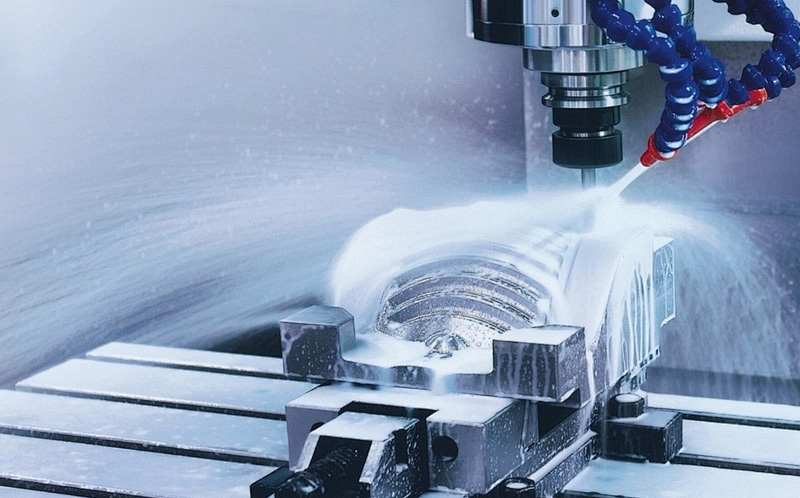- | /
- | /
- | /
- | /
- | /
- | /
Precision Machining and Error Compensation Technologies for CNC Machine Tools

I. Classification and Characteristics of Machining Errors
1. Static Error Sources
Geometric errors: Arising from manufacturing and assembly deviations, such as guideway straightness error (≤0.01mm/m), lead screw pitch error (≤0.005mm/300mm), and spindle radial runout (≤0.001mm). These errors are stable and can be calibrated through pre-measurement.
Thermal equilibrium errors: Temperature gradients (≤5℃) in components like the spindle and bed, caused by ambient temperature changes when the machine is powered on but not cutting, leading to micro-deformation (typically 0.005-0.02mm).
2. Dynamic Error Sources
Thermal errors: Cutting heat (up to 800-1000℃) and motor heat cause uneven temperature rise in the spindle system, resulting in axial elongation (0.01-0.1mm) and radial expansion (0.001-0.005mm). For example, a high-speed spindle rotating at 15,000r/min can generate a 30-50℃ temperature rise, leading to a 0.015mm machining diameter error.
Force-induced errors: Cutting forces (ranging from hundreds to thousands of newtons) cause elastic deformation of the machine structure (e.g., spindle deflection of 0.001-0.01mm) and tool wear (0.001-0.005mm per hour), particularly evident in thin-walled part machining.
Vibration errors: Self-excited vibration (50-2000Hz) between the tool and workpiece creates surface chatter marks (Ra value increases by 2-5 times), more prominent in high-speed milling of hard materials (HRC>45).
II. Key Technologies for Error Compensation
1. Thermal Error Compensation System
Multi-point temperature monitoring: 8-12 temperature sensors (±0.1℃ accuracy) are placed at key positions (spindle bearings, motors, bed), with 1Hz sampling to capture real-time temperature changes.
Compensation model establishment: A BP neural network algorithm establishes a temperature-deformation mapping (≥95% prediction accuracy), with inputs including temperature difference, operating time, and spindle speed.
Real-time correction: The CNC system invokes the compensation model every 100ms, adjusting tool position via the servo axis (0.0001mm resolution), reducing thermal error by 70-90%.
2. Force-Induced Error Compensation
Cutting force monitoring: A three-component dynamometer (0-5000N range, ±1% accuracy) under the workpiece or tool holder collects real-time cutting force signals.
Stiffness model integration: Machine structural stiffness parameters (e.g., spindle end stiffness 50-200N/μm) are preloaded into the CNC system, calculating deformation (Δ= F/K) from measured force for feedforward compensation.
Adaptive parameter adjustment: When cutting force exceeds thresholds (e.g., 3000N), the system automatically reduces feed rate by 10-30% to avoid excessive deformation—critical for thin-walled parts (wall thickness <5mm).
3. Dynamic Vibration Suppression
Active vibration control: Piezoelectric actuators (<1ms response) on the spindle or worktable generate reverse vibration signals (0-5μm amplitude) based on acceleration sensor data (10kHz sampling), offsetting 60-80% of vibration energy.
Damping optimization: Damping material (loss factor ≥0.3) applied to the bed inner wall reduces resonance amplitude by 50%; integral tool holders (30% higher stiffness) prevent tool vibration.
Process parameter optimization: For high-speed milling, optimal spindle speeds (avoiding ±10% of resonance frequency) selected via stability lobe diagrams reduce surface vibration marks from Ra3.2μm to Ra0.8μm.
III. Precision Machining Support Systems
1. High-Precision Hardware Configuration
Spindle system: Hydrostatic (≤0.0005mm radial runout) or air bearings (<0.0001 friction coefficient) achieve ultra-high rotation accuracy; thermally controlled spindle error ≤0.001mm/1000r.
Feed system: Linear motors (±0.001mm positioning accuracy) replace ball screws to eliminate backlash; glass scales (0.0001mm resolution) provide closed-loop feedback.
Environmental control: Precision workshops maintain constant temperature (20±0.5℃), humidity (50±5%RH), and vibration isolation (<5μm ground amplitude) for stable processing conditions.
2. Advanced Measurement and Calibration Technologies
In-situ measurement: Laser interferometers (±0.5μm/m accuracy) or touch probes (±0.0005mm repeatability) integrate with the machine for on-machine measurement after roughing, with data used directly for fine compensation.
Dynamic calibration: Dual-frequency laser interferometers calibrate feed axis positioning accuracy at different speeds (50-3000mm/min), establishing speed-accuracy correction tables to reduce dynamic errors by 40%.
Traceability system: All instruments trace to national standards, with ≤6-month calibration cycles ensuring reliable compensation values.
IV. Application Scenarios and Effect Verification
1. Typical High-Precision Machining Cases
Aerospace structural parts: For aluminum alloy thin-walled frames (2-3mm thickness), "real-time thermal compensation + variable feed rate" reduces profile tolerance from 0.05mm to 0.015mm, meeting aviation standards.
Precision mold cores: High-speed milling of HRC50 die steel with active vibration control and tool wear compensation achieves Ra0.05μm surface roughness, eliminating post-grinding.
Optical components: Air-floating spindles and multi-axis compensation for optical lenses (form accuracy ≤λ/20, λ=632.8nm) achieve 0.025μm surface error.
2. Technical Economic Benefits
Accuracy improvement: Comprehensive error compensation increases key part accuracy by 2-5 times, raising first-pass yield from 70% to over 95%.
Efficiency enhancement: Integrated on-machine measurement and compensation reduce inspection/rework time by 50-70%, shortening production cycles by 30%.
Cost reduction: High-precision machining avoids expensive special equipment, cutting comprehensive manufacturing costs by 20-40% versus traditional processes.
V. Future Development Trends
1. Intelligent Compensation Evolution
Digital twin-driven prediction: Full-physics machine tool digital twins simulate error evolution under varying conditions (spindle speed, cutting depth), enabling 1-2 second advance predictive compensation.
Self-learning systems: Compensation models optimize parameters via reinforcement learning from historical data (>10,000 pieces), increasing prediction accuracy from 95% to 99%.
2. New Materials and Structures
Low-thermal-expansion materials: Invar alloy (1.2×10⁻⁶/℃ expansion) for spindle sleeves reduces thermal deformation by 60% versus traditional cast iron.
Metamaterial structures: Topology-optimized, 3D-printed lightweight beds with 50% higher stiffness-to-weight ratios fundamentally reduce force-induced errors.
3. Integrated Measurement and Manufacturing
Sub-nanometer measurement: 0.1nm resolution laser heterodyne interferometers meet ultra-precision machining needs (<10nm).
Closed-loop manufacturing: Industrial Internet integration of "design-machining-measurement-compensation" enables fully automated precision control with unattended operation.